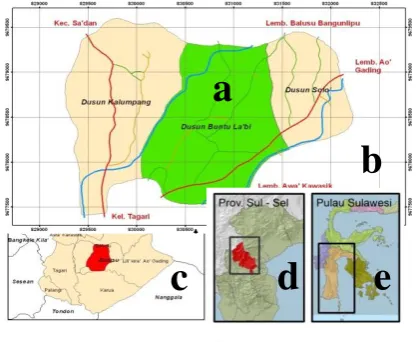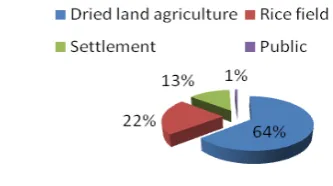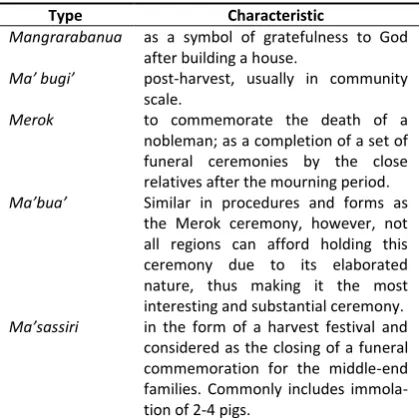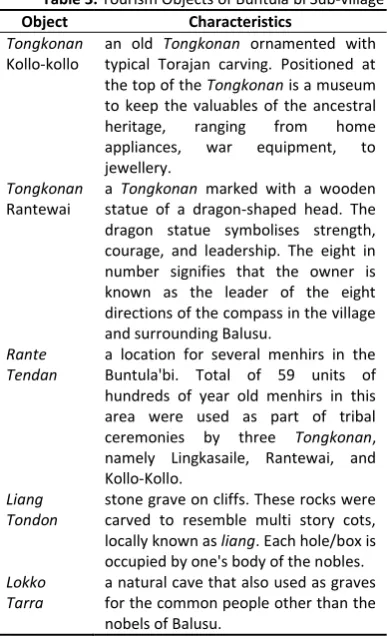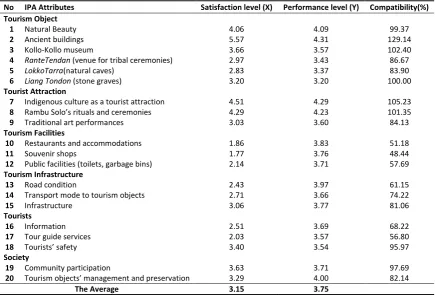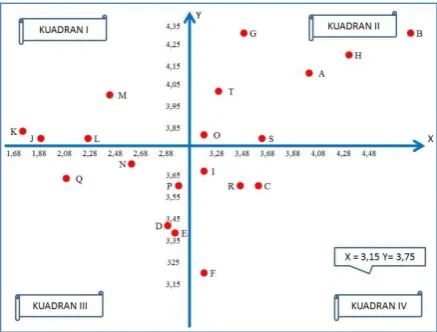e-ISSN: 2338-1647 Development Studies
J.Ind. Tour. Dev. Std., Vol.2, No.3, September, 2014 [95]
Tourism Development Strategy of Buntula’bi Balusu Sub
-village, North Toraja Regency
Based on Tourist Perception
Vica Vanessa Sesaryo Timang
1, Antariksa
2, Ismu Rini Dwi Ari
21
Master Program of Urban and Regional Planning, Faculty of Engineering, University of Brawijaya, Malang 2
Department of Urban and Regional Planning, Faculty of Engineering, University of Brawijaya, Malang
Abstract
Buntula’bi Balusu Sub-village located in North Toraja Regency. It is uniquely endowed with diverse cultural heritages, both physical (tangible) and non-physical (intangible) cultures, viable to attract domestic and/or international tourists. The objectives of this research were to identify Buntula’bi physical and non-physical characteristics, analyse the tourists’ perceptions towards Buntula’bi’s tourism objects performances, and formulate the appropriate direction of tourism development within the sub-village. The research employed descriptive and evaluative analytical methods through observations on primary data, questionnaires, documentation, and a set of literature reviews. An evaluative approach was used to measure tourists’ level of satisfaction towards the tourism objects performances. Tourism component variables were assessed using Importance Performance Analysis (IPA). Descriptively, the physical characteristics in the study site were in the form of ancestral buildings, which included tongkonan Kollo-Kollo, tongkonan Rantewai, togkonan Lingkasile, alang, banuabugi’, and also traditional buildings of kombongan, rantetendan, ranteissun, liangtondon, lokkotarra, and sawahadat. Meanwhile, the non-physical characteristics were identified as indigenous traditions in the forms of tribal cultures and ceremonies such as Aluk Todolo, Rambu Solo’ and RambuTuka’. The IPA result showed that the top priority for the tourism development strategy in Buntula’bi was to improve public facilities, optimize road conditions, and develop restaurants and accommodation, as well as souvenir shops in Buntula’bi Balusu Sub-village.
Keywords: Importance Performance Analysis, tourism development, Toraja.
INTRODUCTION
Cultural tourism in the tourism domain is a type of tourism resulting from a cultural attraction of a particular region. In living culture, the plausible elements to become attractions include the tribal traditions, religious rituals or ceremonies, and art performances. Whereas in cultural heritage, attractions can be in the form of historical artefacts, cultural landscapes, and many others [1]. Due to its uniquely distinctive heritage, Toraja has captivated countless domestic and international tourists’ attention. Balusu is one of the regions in Northern Toraja Regency which is rich in such cultural heritage. This region consists of three smaller Sub-village, namely Kalumpang, Buntula’bi, and Solo’. Amongst them, Buntula’bi Sub-village is chosen as a study area because of the existence of many ancestral buildings and traditional villages conceivable for future tourism development in its site.
Correspondence address: Vica Vanessa Sesaryo Timang
Email : [email protected]
Address : Master Program of Urban and Regional Planning, University of Brawijaya, Jl. Veteran Malang 65145
According to the 2013 data of The Department of Culture and Tourism of Northern Toraja, in spite of being not designated yet as an official Indonesian heritage site, some artefacts in this sub-village have been listed in the Northern Toraja heritage sites’ list. The artefacts include the Tongkonan Balusu (inventory number 1022) and Tongkonan Kollo-Kollo (inventory number 1012).
J.Ind. Tour. Dev. Std., Vol.2, No.3, September, 2014 [96] MATERIALS AND METHODS
Study Area
Buntula'bi Sub-village located in the Village of Balusu, Balusu Sub-district, North Toraja Regency, South Sulawesi Province. The total area of Buntula’bi Sub-village is approximately 250 ha with mountainous and hilly topography. Other geographical characteristics include: an altitude of 890 m asl, steepness level of 8-25%, rainfall intensity of 3,645 mm per year, a temperature range of 14-25°C, and humidity level of 82-86%. Demographically, this sub-village is home for a relatively small population, about 419 residents.
The viable tourism potencies are ancestral buildings, traditional villages, traditional art performances, tribal rituals and ceremonies, such as funeral ceremony which locally known as
Rambu Solo’ and thanksgiving ceremony known as
RambuTuka’. Rituals and ceremonies in Balusu are the most anticipated ceremony by tourists to date because Balusu considered as the land for nobles that suggests a significantly more elaborate standard for traditional ceremonies.
Figure 1. Study Area of Buntula’bi Sub-village Description:
a. Buntula’bi Sub-village b. Balusu Village c. Balusu Sub-district d. North Toraja Regency e. South Sulawesi Province
Data Analysis
This research employed a quantitative descriptive analytical method. It can be explained as a methodology based on positivism and used as a means to assess a particular population or sample [2]. The determination of tourist sample number for this research was done using the Sample Linear Time Function [3] (n = (T – to) / ti), which was 35 tourist respondents.
Physical and non-physical characteristic
Using an explorative descriptive analytical method, this method covers analysis on land use, traditional village, traditional ritual and ceremony.
The explorative descriptive approach explains actual phenomenal characteristics. It also comprehends the actual phenomena by the assessment on a set of alternatives in order to suggest new initiatives through observations, interviews, and questionnaires [4].
Respondents were traditional leaders who controlled the history, knowledge, ancient buildings and attractions in the sub-village or village head of Buntula'bi and understand the context of cultural tourism. The questions were focused to determine the condition of the building and the environment, Toraja culture and the relationship between the utilization of space, and the validity of traditions, rituals and ceremonies. Importance Performance Analysis (IPA)
This method was used to analyze tourists’ perceptions towards the attributes of tourism objects’ performances in order to formulate a tourism development strategy in Buntula’bi Sub-village.
IPA is a combination of perceptions towards the satisfaction and importance level [5]. Using a Likert scale with 5 different levels: very unimportant, unimportant, somewhat important, important, and very important.
The equation for this method is:
Description:
Tki = parallel level Xi = satisfaction score Yi = importance score
Furthermore, in the Cartesian coordinate diagram, the X axis in the satisfaction level, whereas, the Y axis is the importance level based upon the following equations.
Description:
X = average score for satisfaction level Y = average score for importance level n = number of respondents.
To determine the objective margins represented by the coordinate of x, y, the following equations were used.
Description:
K = number of items or attributes scored by the respondents
a
b
J.Ind. Tour. Dev. Std., Vol.2, No.3, September, 2014 [97]
Consecutively, the average scores were then mapped in the Cartesian coordinate diagram which had been divided into 4 sections or quadrants (Fig. 2).
Figure 2. IPA Cartesian coordinate diagram Source: Bacon [6]
RESULTS AND DISCUSSION Land Use Pattern
Land use in Buntula’bi Sub-village is dominantly utilized as dry agricultural land (160 ha, 64%), rice farmland (55 ha, 0.55%), and the remaining as settlements and public facilities (35 ha, 0.35%) (Balusu Village Strategic Plan in 2011). The proportion of land use can be seen in Figure 3.
Figure 3. Land Use Pattern in Buntula’bi Sub-village
Ancient buildings
Tongkonan, the indigenous traditional house in Toraja, is such an exotically ancient type of building that attractive enough to draw the attention of tourists. The sub-village is home for at least 10 units of Tongkonan, each of which is owned by a group of families, namely Tongkonan of Lingkasile, Rantewai, Kollo-kollo, Bellolinggi, Lengkong, Malenong, Nusu L Limbong, Nenek Nita, Ne’ Masero and Tanete (Fig. 4).
Figure 4. Tongkonan: a. Lingkasaile, b. Rantewai, c. Kollo-Kollo
Total of 116 buildings units in the sub-village have been identified. The most dominant use of these units is as rice barns known as Alang, elevated or stage houses known as Banua’ Bugi,
modern houses, and ancestral houses known as
Tongkonan, which accounts for 43.27%, 25%, 16.35% and 15.38%, respectively (Fig. 5).
Figure 5. Ancestral buildings in Batula’bi Sub-village: a. Tongkonan Kollo-Kollo
b. Alang at Tongkonan Rantewai c. Banua’ Bugi at Tongkonan Kollo-Kollo d. Modern House at Tongkonan Kollo-Kollo
Tongkonan is Torajan north-south orienting traditional housing that functions as a residence, a knowledge centre, and an indigenous institution.
Alang is a common name for rice barns and storage for other valuables which is located facing the Tongkonan. Banuabugi’ is a wooden elevated house that functions as a private residence.
Banuabiasa or modern house is also a private residence made of either wood or bricks. These four types of buildings commonly constitute a traditional Torajan neighborhood.
Traditional Village
A traditional village in Buntula’bi Sub-village consists of several elements, i.e. a community land known as Kombongan, venues to hold tribal ceremonies known as Rante Tendan and
RanteIssun, stone graves known as Liang Tondon, natural caves known as Lokko Tarra, and community of rice farmlands. No particular arrangement of these traditional elements is found, however, each of them exists as an integral part of a Torajan traditional settlement (Fig. 6).
a
b
c
a
b
J.Ind. Tour. Dev. Std., Vol.2, No.3, September, 2014 [98]
Figure 6. Traditional village:
a. Kombongan (community land)
b. Rante Tendan (venue for tribal ceremonies) c. RanteIssun (venue for tribal ceremonies) d. Liang Tondon (stone graves)
e. LokkoTarra (natural caves) f. Community of rice farmland
Traditional ceremony
Traditional ceremonies are prevalent in every aspect of life in the Torajan society. Rambu’ Solo
and Rambutuka are some of the ceremonies that portray their indigenous beliefs [7].
The Rambu Solo' ceremony (funeral ceremony) The Rambu Solo' ceremony is the most attractive ceremony for tourists, as seen from the satisfaction score of 4.29% and the importance score of 4.23%. Rambu Solo’ ceremonial is a sacred funeral ceremony in the ancestral beliefs, known as Aluk Todolo, with offerings of many sacrificial animals, such as buffalo and pigs for the dead as a tribal requirement that would guide his/her soul to the life after death. Table 1 explains the stages of
Rambu Solo’ ceremony.
Table 1. Stages of Rambu Solo’ ceremony
Day of the occasion
Number of offerings Stages of AlukRambu
Solo’
Buffalos Pigs
One day - - Disili’
Two days - 1-3 Dipasangbongi Three days 1-2 6-2 Dipatallubongi Four days 3-5 7-10 Dipalimangbongi Five days 6-7 11-20 Dipapitungbongi Six days 8-11 21-40 Rapasan Seven days 21-23 41-50 Rapasansundun Eight days 24-40 51-100 Rapasansapurandanan
Source: Tulak [8]
Figure 7. Rambu Solo’ ceremony:
a. Rambu Solo’ in the olden days b. Ma’badong, a mandatory dance
c. Ma’tinggorotedong and d. Mantarimatamu, the guest welcoming
Rambu Tuka’ ceremony (thanksgiving ceremony) The ceremony is identified as a joyous thanksgiving ceremony, also known as Aluk Rampe Matallo or a religious ceremony conducted at the time when the sun is rising. It is commonly conducted in the morning times (eastern), either in the forms of a harvest feast, traditional house parties, or wedding ceremonials (Table 2).
Table 2. Types of RambuTuka’ ceremony
Type Characteristic
Mangrarabanua as a symbol of gratefulness to God
after building a house.
Ma’ bugi’ post-harvest, usually in community scale.
Merok to commemorate the death of a
nobleman; as a completion of a set of funeral ceremonies by the close relatives after the mourning period. Ma’bua’ Similar in procedures and forms as
the Merok ceremony, however, not all regions can afford holding this ceremony due to its elaborated nature, thus making it the most interesting and substantial ceremony. Ma’sassiri in the form of a harvest festival and considered as the closing of a funeral commemoration for the middle-end families. Commonly includes immola-tion of 2-4 pigs.
Characteristics of Tourism Components
In general, tourism components consist of supply and demand. The following description is the explanation of supply and demand of tourism in the study area.
a
b
c
d
e
f
a
b
J.Ind. Tour. Dev. Std., Vol.2, No.3, September, 2014 [99]
Tourism Objects
The dominant tourism objects existed in Buntula’bi Sub-village are hundreds of year old
Tongkonans, such as Tongkonan of Lingkasaile, Rantewai, Kollo-Kollo and Belolinggi'. There are also Kollo-Kollo museum, Rante Tendan, Liang Tondon and Lokko Tarra. The following table explains the characteristic of tourism objects in Buntula’bi Sub-village (Table 3).
Table 3. Tourism Objects of Buntula’bi Sub-village
Object Characteristics
Tongkonan Kollo-kollo
an old Tongkonan ornamented with typical Torajan carving. Positioned at the top of the Tongkonan is a museum to keep the valuables of the ancestral heritage, ranging from home appliances, war equipment, to jewellery.
Tongkonan Rantewai
a Tongkonan marked with a wooden
statue of a dragon-shaped head. The dragon statue symbolises strength, courage, and leadership. The eight in number signifies that the owner is known as the leader of the eight directions of the compass in the village and surrounding Balusu. ceremonies by three Tongkonan, namely Lingkasaile, Rantewai, and Kollo-Kollo.
Liang Tondon
stone grave on cliffs. These rocks were carved to resemble multi story cots, locally known as liang. Each hole/box is occupied by one's body of the nobles. Lokko
Tarra
a natural cave that also used as graves for the common people other than the nobels of Balusu.
Tourist Attraction
A tourist attraction is an attraction that able to attract tourists who want to visit [9]. The forms of attractions in Buntula’bi Sub-village include activities such as:
Something to do (visiting the tongkonan, mountain tracking, cycling);
Something to see (enjoying the natural beauty, visiting Liang Tondon, visiting Lokko Tarra, visiting Kollo-Kollo museum, and attending art performances)
Something to memorize (witnessing rituals and ceremonies of Rambu Solo' and RambuTuka).
Detailed information about the traditional art as tourist attractions in Buntula'bi Sub-village showed in Table 4.
Table 4. Traditional Dances in Buntula’bi Sub-Village
Traditional
Dance Meaning and Forms of The Dance
Rambu Tuka’ (thanksgiving ceremony)
Ma’ Gellu As the most popular dance, this dance is performed in ceremonies such as wedding celebration, harvest feast and guest welcoming. Performed by 5 or more female dancers using special costumes and accessories such as antique gold. Pa’ Bonebala Similar to Ma’Gellu except for the drum
rhythms and the existence of a special song sung while dancing.
Ma’ Dandan Performed by women dressed in complete white with traditional accessories known as Sa’pi (a head dress resembling Torajan house roof) as they dance to the music.
Manimbung The dance is performed by a man dress in
black and accessorized by a matching headband made of chicken feathers. It is performed as a respect symbol to the late ancestors as harvest festival and a house played interspersed with screams. KelluTungga’ This dance is performed with a chanting
poem about a person’s journey according to the person’s social status. It is commonly performed at harvest celebrations.
Rambu Solo’ (the funeral ceremony)
Ma’ Badong Performed by a group of people forming a circle. In this dance, the dancers spin while a mourning song is played. It can be performed by both males and females. The dance tells a story of a human’s life.
Memanna This dance is performed in a funeral
ceremony of someone being murdered. Ma’ Jogge’ Intended to welcome guests at the
funeral of a noble person. Dancers are all dressed in black with a distinctive head dress known as Sa’pi.
Pa’ Pangan This dance is often performed by the girls to greet guests
Ma’ Randing It danced to drop off and pick up guests at the funeral of the nobles. It danced by men with accessories such as attributes of war, e.g. spears, machetes and shields.
Tourist Facilities
J.Ind. Tour. Dev. Std., Vol.2, No.3, September, 2014 [100] Tourism Infrastructure
Tourism infrastructures in the sub-village are generally provided in good condition. These include roads (access), water supply, sewerage, waste management, communication and drainage.
Tourist
Tourists’ perceptions at tourist objects in Buntula’bi Sub-village is recapitulated according to their percentage and average scores toward each tourism attribute (Fig. 8).
Figure 8. Satisfaction level and object’s performance Legend:
1. Natural beauty
2. Ancient buildings
3. Kollo-kollo museum
4. RanteTendan
5. LokkoTarra natural caves
6. Liang Tondon
7. Indigenous culture as a tourist attraction
8. Rambu Solo’s rituals and ceremonies
9. Traditional art performances
10.Restaurants and accommodation
11.Souvenir shops
12.Public facilities (toilets and garbage bins)
13.Road condition
14.Transport mode to tourism objects
15.Infrastructure
16.Information
17.Tour guide service
18.Tourists’ safety
19.Community participation
20.Tourism objects’ management and preservation.
Public
Most of the Buntula’bi locals are inclined to the development of tourism in the sub-village as identified from 69% of the respondents. Demographically, the community comprises of 50.1% women, 57.28% Christians, and a significant 71.84% farmers.
Tourists’ perceptions toward the service of
performance attraction
The tourists’ satisfaction level of the objects’ performance in Buntula’bi Hamlet is based on the tourism components (Table 5). X is the satisfaction value level, Y is the importance value level, and Tik is the compatibility level.
Table 5. Saticfaction and Importance Levels of Tourist Objects in Buntula’bi Sub-Village
No IPA Attributes Satisfaction level (X) Performance level (Y) Compatibility(%) Tourism Object
1 Natural Beauty 4.06 4.09 99.37
2 Ancient buildings 5.57 4.31 129.14
3 Kollo-Kollo museum 3.66 3.57 102.40
4 RanteTendan (venue for tribal ceremonies) 2.97 3.43 86.67
5 LokkoTarra(natural caves) 2.83 3.37 83.90
6 Liang Tondon (stone graves) 3.20 3.20 100.00
Tourist Attraction
7 Indigenous culture as a tourist attraction 4.51 4.29 105.23
8 Rambu Solo’s rituals and ceremonies 4.29 4.23 101.35
9 Traditional art performances 3.03 3.60 84.13
Tourism Facilities
10 Restaurants and accommodations 1.86 3.83 51.18
11 Souvenir shops 1.77 3.76 48.44
12 Public facilities (toilets, garbage bins) 2.14 3.71 57.69
Tourism Infrastructure
13 Road condition 2.43 3.97 61.15
14 Transport mode to tourism objects 2.71 3.66 74.22
15 Infrastructure 3.06 3.77 81.06
Tourists
16 Information 2.51 3.69 68.22
17 Tour guide services 2.03 3.57 56.80
18 Tourists’ safety 3.40 3.54 95.97
Society
19 Community participation 3.63 3.71 97.69
20 Tourism objects’ management and preservation 3.29 4.00 82.14
J.Ind. Tour. Dev. Std., Vol.2, No.3, September, 2014 [101]
Based upon the IPA analysis and also by considering the satisfaction and importance value of the tourism components variables in table 5, the distribution of each attribute is depicted in a Cartesian coordinate diagram below (Fig. 9).
Figure 9. The distribution of tourist satisfaction towards Buntula'bi Sub-villaget attraction.
Legend:
A. Natural beauty
B. Ancient buildings
C. Kollo-kollo museum
D. RanteTendan
E. LokkoTarra natural caves
F. Liang Tondon
G. Indigenous culture as a tourist attraction
H. Rambu Solo’s rituals and ceremonies
I. Traditional art performances
J. Restaurants and accommodation
K. Souvenir shops
L. Public facilities (toilets and garbage bins)
M. Road condition
N. Transportation modes to tourism objects
O. Infrastructure
P. Information
Q. Tour guide service
R. Tourists’ safety
S. Community participation
T. Tourism objects’ management and preservation.
The output of this analysis suggests improvement priority based upon the distribution of each attribute in each quadrant [9]. The detailed explanation of the quadrants is as follow:
Quadrant I, Concentrate here (top priority): including 4 attributes, i.e. public facilities, road condition, restaurants and accommodation, and souvenir shops.
Quadrant II, Keep up the good work, including 7 attributes i.e. Natural beauty, ancient buildings, the indigenous culture as a tourist attraction, Rambu Solo’s rituals
and ceremonies, infrastructure, community participation, and the tourism objects’ management and preservation.
Quadrant III, low priority, including 5 attributes, i.e. Rantetendan, LokkoTarra
natural caves, transportation modes to tourism objects, information, and tour guide services.
Quadrant IV, possible to overkill (excessive), including 4 attributes i.e. Kollo-Kollo museum, Liang Tondon, traditional art performances, and tourists’ safety.
Tourism development strategy based on the
perception of Buntula’bi tourists
Based on the IPA analysis, the alternative strategy for tourism development in Buntula’bi Hamlet can be elaborated to the following: Quadrant I, concentrate here/top priority (high importance level, low satisfaction level). The strategies are:
- Improving the public facilities such as toilets
and garbage bins to support tourist amenities.
- Optimizing the road conditions (especially the
Balusu axis) to provide better access to Buntula'bi.
- Developing restaurants and accommodations.
- Developing souvenir shops.
Quadrant II, keep up the good work/keep achievement (both high importance and satisfaction level). The strategies are:
- Preserving and maintaining the natural
environment.
- Preserving traditional characteristics and
values of both buildings and villages.
- Preserving and maintaining indigenous
culture as a tourist attraction.
- Preserving and maintaining the traditional
rituals and ceremonies of Rambu Solo'.
- Maintaining the infrastructure such as roads
(access), drainage, water supply, communication in Buntula'bi.
- Maintaining community participation by
involving them in the environment resto-ration and preservation processes.
- Maintaining all kinds of tourism objects to
boost tourist attraction.
Quadrant III, low priority (low important and satisfaction level), the directions are:
- Restoring the function of Rante Tendan as a
venue for traditional ceremonies such as
J.Ind. Tour. Dev. Std., Vol.2, No.3, September, 2014 [102]
- Designating the natural cave of Tarra Lokko as
the burial site for the common people of Buntula'bi.
- Granting public transportation access to the
objects for easier accessibility.
- Providing sufficient information about
tourism objects.
- Providing additional tour guide services;
though tourists are satisfied with the current availability of local tour guides.
Quadrant IV, possible to overkill/excessive (low importance level, yet high satisfaction level).
- Sustaining the maintenance of the Kollo-Kollo
museum.
- Sustaining the maintenance of Liang Tondon
as a burial place for the nobles in Buntula'bi.
- Sustaining support for the dance studio and
pa'katia (a guest welcoming group) for art performances.
- Ensuring tourists’ safety by maintaining
indigenous values of Buntula'bi as a safe and secure traditional neighborhood.
CONCLUSION
The tourism potential in Buntula’bi Sub-village is a constitution of ancient buildings and traditi-onal environment. Based upon the IPA analysis, the top priorities in tourism development strategy are formulated to:
Improve public facilities
Optimize road condition for better access Develop more restaurants and
accommoda-tions
Develop souvenir shops
Also given the good performing aspects in Quadrant II (keep up the good work), the tourism developments strategy in Buntula’bi should also be taken to:
Maintain and take care for the natural beauty Maintain the characteristics of ancient
buildings
Maintain the attractive activities (local heritage) as the tourist attraction
Maintain the rituals and ceremonies such as
Rambu Solo'.
Maintain the internal utilities
Maintain the community involvement in the restoration and conservation of environment Maintain and keep the attraction as a form of
management and protection of attraction.
REFERENCES
[1]. Sarm, C. 2013. Managing interpretation at UNESCO World Heritage Site: A supplay-side
perspective of Angkor Wat Temple, Cambodia. Master Thesis. Master Of Tourism Management, Victoria University of Wellington.
[2]. Sugiyono. 2009. Research methods quantitative, qualitative and R&D. Bandung. Alfa Beta.
[3]. Arikunto, S. 2006. Research procedure, A practical approach. Jakarta. RinekeCipta. [4]. Sari, E.S. 1999. Audience research. Jakarta.
Ghalia Indonesia.
[5]. Martilla, J.A., and James, J.C. 1977. Importance Performance Analysis. Journal of Marketing 41, 77-79.
[6]. Bacon, D. 2003. A comparison of approaches to Importance – Performance Analysis. International Journal of Market Research XXXV(2), 55-71.
[7]. Palebangan, F.B. 2007. Aluk, Mores of Toraja. Tana Toraja. Sulo Publisher.
[8]. Tulak, D. 2008. Kada Disedan Sarong Bisara DiToke’ Tambane Baka. Tana Toraja. Tourism and Cultural Agency.
